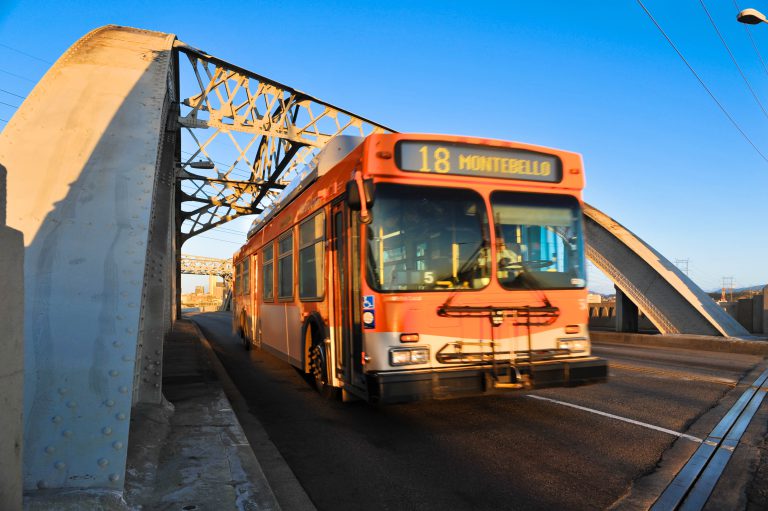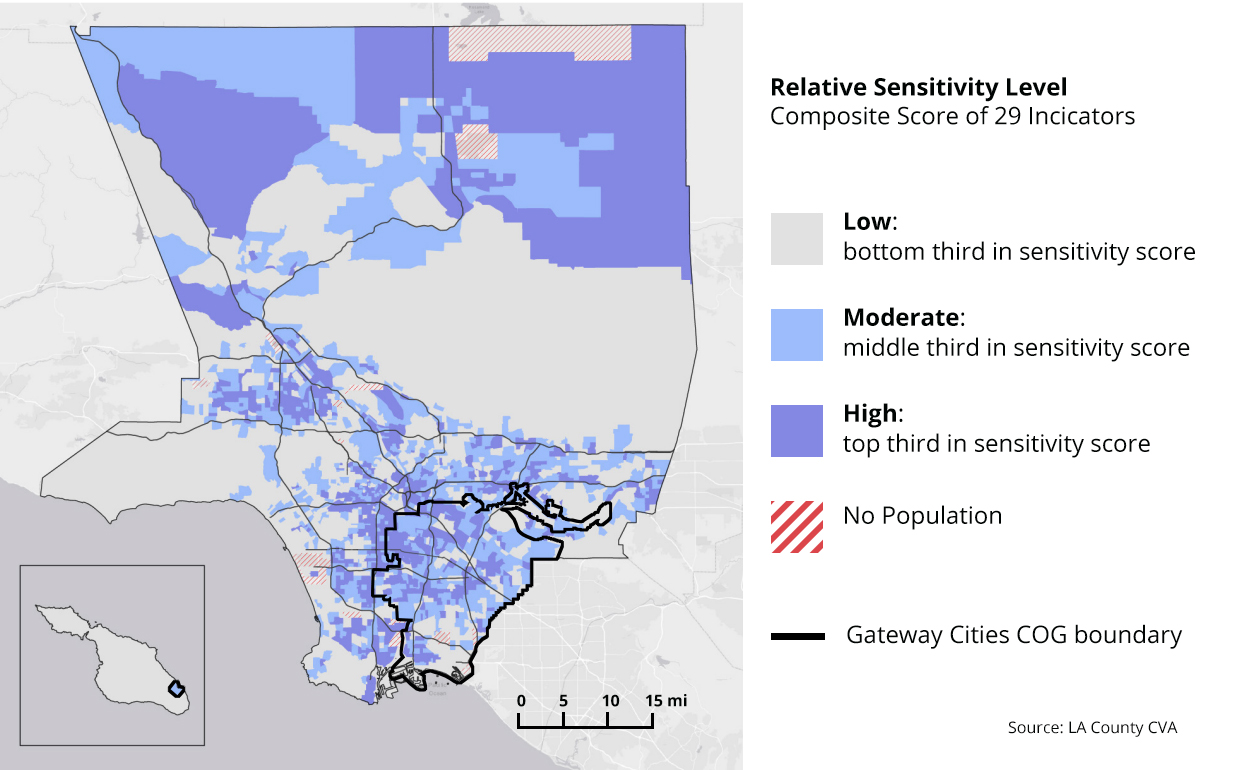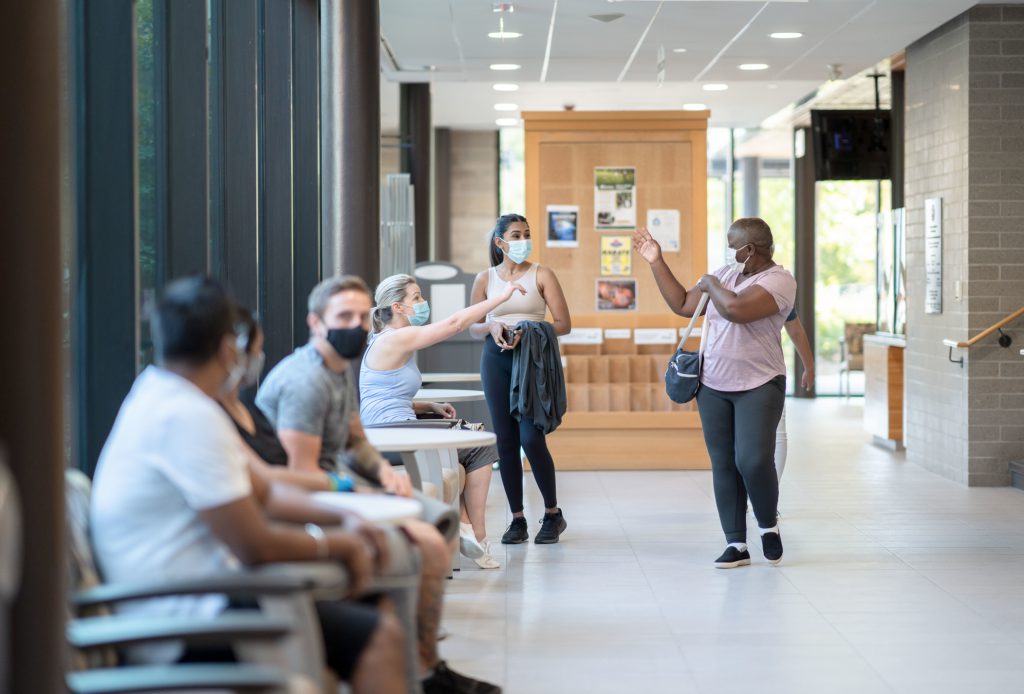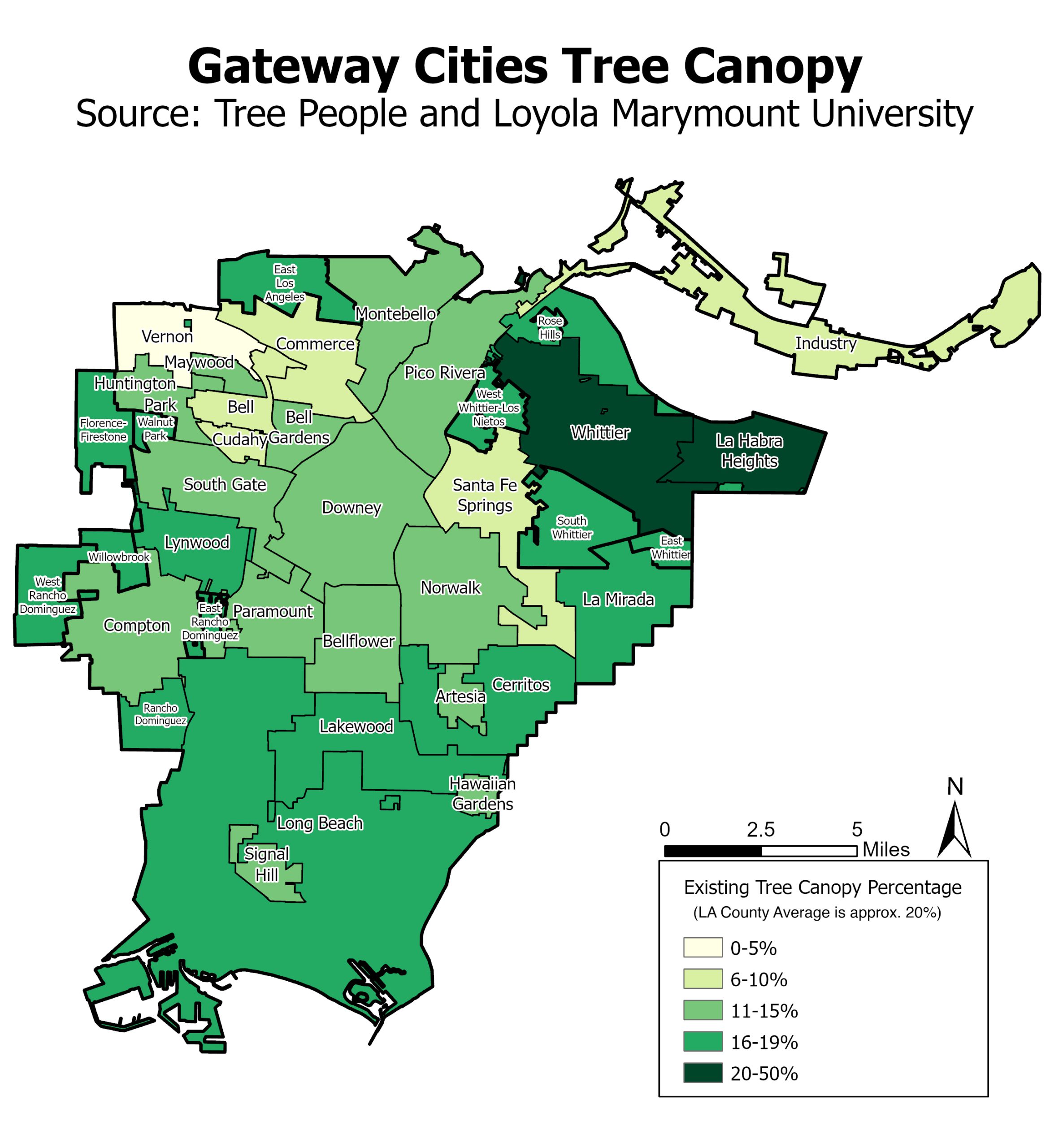Climate Change in the Gateway Cities
Gateway Cities Council of Governments and Climate Change
As climate change continues to transform the lives of residents in Los Angeles County, the region is coming to grips with its environmental effects, including record-breaking temperatures, longer droughts, and more intense wildfires. These issues stress the County’s communities, infrastructures, health, and essential natural resources. Climate projections indicate that the destructive effects of climate change are only expected to grow more severe in the coming decades.
One area of Los Angeles County that is particularly vulnerable to these harmful effects is encompassed by the Gateway Cities Council of Governments (COG). The Gateway Cities COG is the coordinating organization for Southeast Los Angeles County and is one of several jurisdictional subregions that divide the county. The Gateway Cities COG comprises 27 cities in Southeast LA, representing 2.1 million people. Three-quarters of the residents in the Gateway Cities COG reside in census tracts that have been classified by CalEPA as “disadvantaged.” These disadvantaged tracts are largely composed of urban low-income communities of color, specifically Black and Latinx residents



Although climate change impacts everyone, disadvantaged communities disproportionately bear the brunt of climate change burdens, and are much less resilient to it than other communities. When compared with broader Los Angeles County, households in the Gateway Cities COG fare worse on a broad range of metrics. Gateway Cities have lower median household income, lower high school and college graduation rates, and higher unemployment rates. The Gateway Cities COG has a higher overall Pollution Burden Score – a measure of potential pollutant exposure and harmful environmental conditions – than the County average. Additionally, residents in the Gateway Cities COG have a higher per capita number of asthma and cardiovascular-related ER visits than their counterparts in greater Los Angeles County while having lower health insurance rates. These health disparities are the result of a combination of factors, including pollution exposure from highways and goods movement, a concentration of emitters, overcrowded housing as well as a history of systemic racism, housing discrimination, segregation, and a lack of resources.
Social Sensitivity and Adaptive Capacity in the Gateway Cities COG
As an implementation action of the Our County Sustainability Plan, the LA County Chief Sustainability Office commissioned the LA County Climate Vulnerability Assessment (CVA) to look at the climate change threats facing LA County and consider how those threats affect different communities. As a key part of determining the sensitivity of communities to climate threats, the CVA examined 29 Social Sensitivity indicators across 10 categories (see table). That data was used to generate the three-tiered ‘Social Sensitivity’ map of LA County seen below.
|
Category
|
Social Sensitivity Indicators
|
|---|---|
|
Age
|
children, older adults, older adults living alone
|
|
Community & language
|
foreign-born, female, female householder, library access, voter turnout rate, limited English Proficiency
|
|
Occupation
|
outdoor workers (including workers in agriculture, fishing, mining, extractive or construction occupations), unemployment
|
|
Education
|
no high school diploma
|
|
Health
|
disability, asthma, cardiovascular disease, no health insurance
|
|
Housing
|
living in group quarters, mobile homes, cost-burdened, renters
|
|
Income & Wealth
|
median income, poverty
|
|
Race / Ethnicity
|
black, Asian, Hispanic / Latinx, Indigenous
|
|
Access to Information
|
no internet subscription
|
|
Transportation
|
households without vehicle access, transit access
|

The map below focuses solely on the Gateway Cities COG and the data have been aggregated to the city level for each municipality. The visualization shows the Sensitivity level (low, moderate, high) for each city, along with its Social Sensitivity score. Each city’s Social Sensitivity ranking within the Gateway cities COG and its population are also displayed. While the countywide Social Sensitivity score is .069, the Gateway Cities COG average is considerably higher at .47, (higher scores indicate areas with greater sensitivity). All but one of the Gateway cities has either moderate or high Social Sensitivity.
In addition to Social Sensitivity, when it comes to coping with climate change, disadvantaged communities often have low “adaptive capacity.” A community’s adaptive capacity refers to its ability to adjust and cope with the consequences of climate-related events. Social Sensitivity, exposure to climate threats, and adaptive capacity together determine the overall climate vulnerability of a community. A population with increased exposure to climate hazards, a high sensitivity to the negative impacts of that exposure, and low adaptive capacity is said to have “high climate vulnerability.” To better understand a community’s climate vulnerability, it is necessary to look at the specific climate threats it faces.
Specific Climate Threats for the Gateway Cities COG Subregion
The CVA identifies extreme heat, wildfire, inland flooding and extreme precipitation, coastal flooding, and drought as the most pressing climate hazards for Los Angeles County as a whole. In terms of the specific vulnerability of the Gateway Cities COG, extreme heat is arguably the most significant threat to communities and infrastructure given the region’s geography and social sensitivity. In the coming decades, the countywide daily maximum temperature will rise by an average of 5.4 degrees Fahrenheit and the average number of heat waves is expected to increase tenfold by mid-century. At that time, projections indicate that it is probable that most of the county will have shifted to moderate or high exposure to extreme heat. The below visualization displays the projected average number of extreme heat days for incorporated cities in the Gateway Cities COG for the years 2035-2064.

More annual deaths in the United States are related to extreme heat than any other single weather-related hazard. Communities with proportionally high numbers of children and the elderly are sensitive to extreme heat. High temperatures can intensify the creation of ground-level ozone which exacerbates many pre-existing cardiovascular and respiratory illnesses. Outdoor workers in construction and agriculture with prolonged heat exposure are particularly vulnerable. The CVA notes that the City of Industry, Santa Fe Springs, Vernon, and Long Beach have the most climate-exposed workers in Los Angeles County. Those experiencing homelessness, living in vehicles or mobile homes are also susceptible to elevated temperatures. Additionally, low-income residents unable to afford air-conditioning are forced to endure long, potentially dangerous, heat waves. The CVA reports that increased temperatures have been associated with a rise in emergency room visits for mental health issues, self-injury / suicide, and intentional injury / homicide. Finally, people with traumatic brain injuries, skin conditions, pregnant women, and those with developmental disorders like autism can struggle with extreme heat.
Extreme heat days also increase the burden on energy infrastructure. As people consume more electricity to cool their homes and businesses, more stress is placed on power grids, which increases the likelihood of power outages occurring. Beyond causing power-related shortages and disrupting transportation, power outages can prove to be extremely dangerous for people who have heat-related health complications and need electricity to cool vital medications and power medical devices.
Building Climate Resilience
The overall objective for both LA County and the Gateway Cities COG is to develop greater resilience to climate shocks and stresses like extreme heat. Extreme heat manifests as a prolonged and growing threat rather than a discrete event like a wildfire or flood, which allows for some measure of planning. Natural systems and the built environment play an important role in our ability to withstand rising temperatures. The CVA identified five resources that can help communities adapt to extreme heat. Three of them: proximity to heat refuge, park access, and tree canopy are relevant to this discussion.

Air-conditioned heat refuges include official cooling centers, which are often located in public facilities such as community and senior centers, as well as other indoor public locations like libraries and museums. Private spaces such as indoor shopping malls and movie theaters may also be included, although access to these spaces can be limited or constrained by one’s ability to pay for the services or goods they provide. These spaces can be a critical sanctuary for people who lack air conditioning at home. If these spaces can be powered with off grid renewable energy sources, they can continue to serve residents when extreme heat triggers power outages that make the electricity grid inaccessible.
Parks are another vital piece of resilience infrastructure that can help a community brace against extreme heat. They reduce local ambient temperature, provide free shade, and often have facilities for people to rest and hydrate. Access to green spaces has been shown to lessen anxiety and depression , and parks often serve as places of social connectedness for community members, making parks a holistic remedy to problems caused by extreme heat. Park access varies considerably for incorporated cities in the Gateway Cities COG (see chart at right).
Finally, the urban tree canopy serves several important functions. On top of having the ability to improve air quality by capturing particulate air pollution and carbon dioxide, through a process called evapotranspiration, tree canopies also reduce the urban heat island effect created when pavement and concrete trap and retain heat, especially in socially vulnerable communities. Additionally, trees provide habitat for birds and other wildlife and give shade for residents on sidewalks. The distribution of the urban tree canopy across the Gateway Cities COG can be seen in the visualization below.

Help for the Gateway Cities COG
Based on their relative climate vulnerability within the Gateway Cities subregion, the Gateway Cities COG submitted a program pilot idea to support member communities with energy resilience planning through an initiative called the Energy Resilience Action Plan (ERAP). The initiative was approved for piloting in select cities in 2022 and 2023 under the Southern California Regional Energy Network (SoCalREN) Public Agency Programs. SoCalREN provides support to businesses, residents, and public agencies in an effort to reduce energy consumption and plan for some of the climate hazards discussed above.
Through the pilot initiative, the cities of Maywood, Bell, and Bell Gardens were selected as the first three cities to receive ERAP services. The initiative will provide these agencies with tools to support both near and long-term energy resilience planning such as interactive maps, recommendations and opportunities for energy efficiency and distributed energy resource improvements at critical facilities, and resources and references to support long term goal setting. The ERAP will serve as a valuable resource to cities and will allow these cities to plan for, and access funding to better prepare to adapt to the inevitable effects of climate change.
Sources
CalEnviroScreen 3.0 (2018, June 25). California Office of Environmental Assessment. https://oehha.ca.gov/calenviroscreen/report/calenviroscreen-30
Los Angeles County Chief Sustainability Office. (2021). LA County Climate Vulnerability Assessment. https://ceo.lacounty.gov/wp-content/uploads/2021/10/LA-County-Climate-Vulnerability-Assessment-1.pdf
Los Angeles County Chief Sustainability Office. (2019). Los Angeles Countywide Sustainability Plan. https://ourcountyla.lacounty.gov/wp-content/uploads/2019/07/OurCounty-Final-Plan.pdf
National Weather Service. (2021). Weather Related Fatality and Injury Statistics. https://www.weather.gov/hazstat/
SB 535 Disadvantaged Communities (2022, May). California Office of Environmental Assessment. https://oehha.ca.gov/calenviroscreen/sb535
USC Price Center for Social Innovation. (2019). Neighborhood Data for Social Change Project. https://map.myneighborhooddata.org
Weiqi Zhou, Ganlin Huang, Steward T.A. Pickett, Jing Wang, M.L. Cadenasso, Timon McPhearson, J. Morgan Grove, Jia Wang, Urban tree canopy has greater cooling effects in socially vulnerable communities in the US, One Earth, Volume 4, Issue 12, 2021, Pages 1764-1775, ISSN 2590-3322, https://doi.org/10.1016/j.oneear.2021.11.010.

Dan Oberle
Dan Oberle is pursuing a Master of Urban Planning degree at The Price School. Prior to his arrival at USC, Dan worked as a documentary film editor in Los Angeles for many years. At USC he hopes to focus on housing and how the built environment influences cities as complex, social-ecological systems. He believes that design and data can be powerful tools to address the hidden inequities embedded in these systems. Dan holds a bachelor’s degree from Florida State University.

Stephanie Liem
Stephanie is a second year Masters in Public Policy student specializing in International Policy at the Sol Price School of Public Policy. She received her B.A. in 2020 from UC Berkeley, majoring in Global Studies with a concentration in Peace & Conflict. She is also a first generation Indonesian immigrant and Asian American activist whose activism revolves around challenging the Model Minority Myth and building Black and Asian solidarity. During the last two years, she worked as a grassroots organizer and Communications Director at an Oakland based non-profit called Hip Hop For Change. Here, she designed her very own Afro-Asian solidarity curriculum, which she has presented at schools, museums, events, and companies across the country. As an academic, her research interests are in ethnic conflict, Southeast Asian politics, and international governance.

